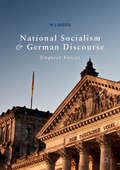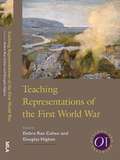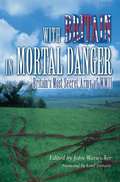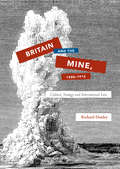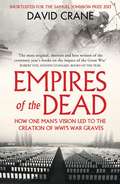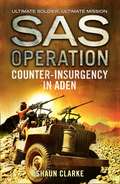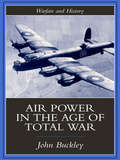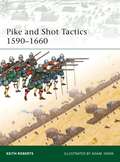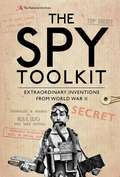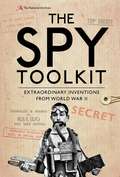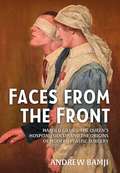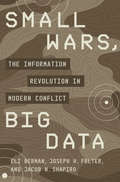- Table View
- List View
National Socialism and German Discourse: Unquiet Voices
by W J DoddIn this discourse history, W J Dodd analyses the ‘unquiet voices’ of opponents whose contemporary critiques of Nazism, from positions of territorial and inner exile, focused on the ‘language of Nazism’. Individual chapters review ‘precursor’ discourses; Nazi public discourse from 1933 to 1945; the testimonies of ‘unquiet voices’ abroad, and in private and published texts in the ‘Reich’; attempts to ‘denazify the language’ (1945-49), and the legacies of the Nazi past in a retrospective discourse of ‘coming to terms’ with the Nazi past. In the period from 1945, the book focuses on contestations of ‘tainted language’ and instrumentalizations of the Nazi past, and the persistence of linguistic taboos in contemporary German usage. Highly engaging, with English translations provided throughout, this book will provide an invaluable resource for scholars of discourse analysis, sociolinguistics, and German history and culture; as well as readers with a general interest in language and politics.
National Socialism and German Discourse: Unquiet Voices
by W J DoddIn this discourse history, W J Dodd analyses the ‘unquiet voices’ of opponents whose contemporary critiques of Nazism, from positions of territorial and inner exile, focused on the ‘language of Nazism’. Individual chapters review ‘precursor’ discourses; Nazi public discourse from 1933 to 1945; the testimonies of ‘unquiet voices’ abroad, and in private and published texts in the ‘Reich’; attempts to ‘denazify the language’ (1945-49), and the legacies of the Nazi past in a retrospective discourse of ‘coming to terms’ with the Nazi past. In the period from 1945, the book focuses on contestations of ‘tainted language’ and instrumentalizations of the Nazi past, and the persistence of linguistic taboos in contemporary German usage. Highly engaging, with English translations provided throughout, this book will provide an invaluable resource for scholars of discourse analysis, sociolinguistics, and German history and culture; as well as readers with a general interest in language and politics.
The Army of the Future (PDF)
by Charles De GaulleCharles de Gaulle's book The army of the future is the ground force version of Giulio Douhet's Command of the Air. de Gaulle describes what his vision of what mobile warfare would be in the future. He begins the book with a very interesting terrain analysis explaining why France has always been open to invasion. From there he describes what a division would look like containing two tank brigades, mechanized infantry, self propelled artillery, engineers, air defense, aviation and logistics. He also describes how these mobile divisions would fight. He explains what type of individuals would be needed to fill the ranks of this highly professional mobile army. My opinion that de Gaulle's vision is closer to the Heavy Divisions of the Cold war is based on de Gaulle calling for two Tank Brigades in his division while the German army of WWII had only one Panzer Regiment in their Panzer Divisions. Also the German Army relied heavily on horse transportation for most all of their artillery. A US Tank Division during the Cold War had two Tank and one Mechanized Infantry Brigade, all artillery was self propelled, this organization was more in line with de Gaulle's division than the Panzer Division was. That said, de Gaulle's vision for ground warfare was far more accurate than Douhet's vision for air power was.
Nuclear Weapons: Operations Manual (PDF)
by David BakerMuch misinformation has been published by those who support, as well as those who are against, the continued deployment of nuclear weapons as instruments of deterrence. This book provides an apolitical description of nuclear weapons, how they are designed, how they work, and how they are assigned to different targets in the event of conflict. The underpinning purpose of the book is to provide a descriptive "manual" on what they are, how they are categorized, how they would be sent to their targets and how they have changed, as revealed through their design and potential application.
Achtung-panzer! (PDF)
by Heinz GuderianThis is one of the most significant military books of the twentieth century. By an outstanding soldier of independent mind, it pushed forward the evolution of land warfare and was directly responsible for German armoured supremacy in the early years of the Second World War. Published in 1937, the result of 15 years of careful study since his days on the German General Staff in the First World War, Achtung Panzer! argues how vital the proper use of tanks and supporting armoured vehicles would be in the conduct of a future war. When that war came, just two years later, he proved it, leading his Panzers with distinction in the Polish, French and Russian campaigns. Panzer warfare had come of age, exactly as he had forecast.This first English translation of Heinz Guderian's classic book - used as a textbook by Panzer officers in the war - has an introduction and extensive background notes by the modern English historian Paul Harris.
Teaching Representations Of The First World War (PDF)
by Debra Rae Cohen Douglas HigbeeThe First World War saw staggering loss of life and was a catalyst for many political and social changes. It was also shaped by the media and art forms that expressed it: film, photography, poetry, memoir, posters, advertisements, and music. This volume's scope shows that today's instructors contend with many different issues in teaching the First World War in a variety of classroom settings. Among these issues are the war's relation to modernism; global reach in the Middle East and South Asia; influence on psychiatry, pacifism, and consumer culture; and effect on public health and the 1918 influenza pandemic.
Nurses Of Passchendaele (PDF)
by Christine E. HallettThe Ypres Salient saw some of the bitterest fighting of the First World War. The once-fertile fields of Flanders were turned into a quagmire through which men fought for four years. In casualty clearing stations, on ambulance trains and barges, and at base hospitals near the French and Belgian coasts, nurses of many nations cared for these traumatized and damaged men.
Op. JB The Last Great Secret of the Second world War (PDF)
by Christopher CreightonUntold story that may be the last great secret of the Second World War.
With Britain In Mortal Danger (PDF)
by John Warwicker Baron IronsideIn 1938 the War Office ordered the Director of Military Intelligence to create a unit that would research the tactics and organisation needed in the event of an invasion. After Dunkirk Lt Col Holland's Military Intelligence (Research) expanded greatly, secretly recruiting civilians and service personnel thought suitable for subversive and irregular warfare. Although never called upon, their story remained shrouded in secrecy for half a century.
Human Nature and the Causes of War
by John David OrmeWhat are the causes of war? Wars are generally begun by a revisionist state seeking to take territory. The psychological root of revisionism is the yearning for glory, honor and power. Human nature is the primary cause of war, but political regimes can temper or intensify these passions. This book examines the effects of six types of regime on foreign policy: monarchy, republic and sultanistic, charismatic, and military and totalitarian dictatorship. Dictatorships encourage and unleash human ambition, and are thus the governments most likely to begin ill-considered wars. Classical realism, modified to incorporate the impact of regimes and beliefs, provides a more convincing explanation of war than neo-realism.
Human Nature and the Causes of War
by John David OrmeWhat are the causes of war? Wars are generally begun by a revisionist state seeking to take territory. The psychological root of revisionism is the yearning for glory, honor and power. Human nature is the primary cause of war, but political regimes can temper or intensify these passions. This book examines the effects of six types of regime on foreign policy: monarchy, republic and sultanistic, charismatic, and military and totalitarian dictatorship. Dictatorships encourage and unleash human ambition, and are thus the governments most likely to begin ill-considered wars. Classical realism, modified to incorporate the impact of regimes and beliefs, provides a more convincing explanation of war than neo-realism.
Britain and the Mine, 1900–1915: Culture, Strategy and International Law
by Richard DunleyThis book examines Britain’s complex relationship with the mine in the years 1900-1915. The development of mine warfare represented a unique mix of challenges and opportunities for Britain in the years before the First World War. The mine represented the antithesis of British maritime culture in material form, and attempts were made to limit its use under international law. At the same time, mine warfare offered the Royal Navy a solution to its most difficult strategic problem. Richard Dunley explores the contested position occupied by the mine in the attitudes of British policy makers, and in doing so sheds new light on the overlapping worlds of culture, strategy and international law.
Britain and the Mine, 1900–1915: Culture, Strategy and International Law
by Richard DunleyThis book examines Britain’s complex relationship with the mine in the years 1900-1915. The development of mine warfare represented a unique mix of challenges and opportunities for Britain in the years before the First World War. The mine represented the antithesis of British maritime culture in material form, and attempts were made to limit its use under international law. At the same time, mine warfare offered the Royal Navy a solution to its most difficult strategic problem. Richard Dunley explores the contested position occupied by the mine in the attitudes of British policy makers, and in doing so sheds new light on the overlapping worlds of culture, strategy and international law.
Empires of the Dead: How One Man's Vision Led to the Creation of WWI's War Graves (PDF)
by David CraneIn the wake of the First World War, Britain and her Empire faced the enormous question of how to bury the dead. Critically-acclaimed author David Crane describes how the horror of the slaughter motivated an ambulance commander named Fabian Ware to establish the Commonwealth war cemeteries. Behind these famous monuments – the Cenotaph, Tyne Cot, Menin Gate, Etaples amongst them – lies a deeply moving story; ‘Empires of the Dead’ chronicles a generation coming to terms with grief on a colossal scale.
Counter-insurgency In Aden (Sas Operation Series (PDF).)
by Shaun ClarkeUltimate soldier. Ultimate mission. But will the SAS be able to rid Yemen of its unstoppable guerrillas? Aden, 1964, and the British are waging two different kinds of war. Inhabitants of northern Yemen’s forbidding mountainous region of Radfan are conducting guerrilla attacks against the British. Armed by the Egyptians and trained by the communist Yemenis, they seem an invincible fighting force. With only one hope of beating them, the British draft in an even more tenacious group of soldiers – the SAS! Their mission: to parachute into enemy territory at night, establish concealed observation posts high in the mountains, and direct air strikes on the rebels moving through the sun-baked passes. At the same time, in an even more dangerous campaign, two- or three-man SAS teams disguised as Arabs must infiltrate the souks and bazaars of the port of Aden in an attempt to ‘neutralise’ leading members of the National Liberation Front. But will their disguise allow them to get close enough to their targets, or get out again alive…?
Air Power In The Age Of Total War (Warfare and History Ser.)
by John BuckleyA fascinating study of the changing military role of air power in the 20th century, this book examines the sensational impact of the Great War, the pioneering work of air power theorists and visionaries in the interwar period, the air arms race, the Second World War in Europe and the Far East, and, finally, the post-war period.
Air Power in the Age of Total War (Warfare and History Ser. #(PDF))
by John BuckleyA fascinating study of the changing military role of air power in the 20th century, this book examines the sensational impact of the Great War, the pioneering work of air power theorists and visionaries in the interwar period, the air arms race, the Second World War in Europe and the Far East, and, finally, the post-war period.
Mussolini and the Salò Republic, 1943–1945: The Failure of a Puppet Regime (Italian and Italian American Studies)
by H. James Burgwyn Amedeo Osti GuerrazziThis book is a long overdue in-depth study of the Italian Social Republic. Set up in 1943 by Hitler in the town of Salò on Lake Garda and ruled by Mussolini, this makeshift government was a last-ditch effort to ensure the survival of Fascism, ending with the murder of Mussolini by partisans in 1945. The RSI was a loosely organized regime made up of professed patriots, apostles of law and order, and rogue militias who committed atrocities against presumed and real enemies. H. James Burgwyn narrates the history of the RSI, with vivid portraits of key figures and thoughtful analysis of how radical fascists managed to take the Salò regime from a dictatorship in Italy to a Continental nazifascismo, hand in hand with the Third Reich. This book stands as an essential bookend to the life of Mussolini, with new insights into the man who duped the Italian people and provoked a war that ended in catastrophic defeat.
Mussolini and the Salò Republic, 1943–1945: The Failure of a Puppet Regime (Italian and Italian American Studies)
by H. James Burgwyn Amedeo Osti GuerrazziThis book is a long overdue in-depth study of the Italian Social Republic. Set up in 1943 by Hitler in the town of Salò on Lake Garda and ruled by Mussolini, this makeshift government was a last-ditch effort to ensure the survival of Fascism, ending with the murder of Mussolini by partisans in 1945. The RSI was a loosely organized regime made up of professed patriots, apostles of law and order, and rogue militias who committed atrocities against presumed and real enemies. H. James Burgwyn narrates the history of the RSI, with vivid portraits of key figures and thoughtful analysis of how radical fascists managed to take the Salò regime from a dictatorship in Italy to a Continental nazifascismo, hand in hand with the Third Reich. This book stands as an essential bookend to the life of Mussolini, with new insights into the man who duped the Italian people and provoked a war that ended in catastrophic defeat.
Pike and Shot Tactics 1590–1660 (Elite #(PDF))
by Keith Roberts Mr Adam HookThroughout the 17th century large parts of Europe were depopulated during the wide-ranging and savage wars of religion and dynasty, involving all of the major powers. This was therefore a key period in the development of 'modern' infantry tactics, such as the use of pole-arms and muskets together hence the popular expression 'pike and shot'. These infantry tactics involved different national schools on thought and practice, and were tested bloodily in great battles. This title covers the Dutch-Spanish wars of independence, The Thirty Years' War and the English Civil Wars.
The Spy Toolkit: Extraordinary inventions from World War II
by The National Archives Dr Stephen TwiggeSpies claim that theirs is the second oldest profession. Secret agents across time have had the same key tasks: looking and listening, getting the information they need and smuggling it back home. Over the course of human history, some amazingly complex and imaginative tools have been created to help those working under the cloak of supreme secrecy.During the Second World War, British undercover agents were the heroes behind the scenes, playing a dangerous and sometimes deadly game – risking all to gather intelligence about their enemies. What did these agents have in their toolkits? What ingenious spy gadgets did they have up their sleeves? What devious tricks did they deploy to avoid detection? From the ingenious to the amusing, this highly visual book delves into espionage files that were long held top secret, revealing spycraft in action.
The Spy Toolkit: Extraordinary inventions from World War II (PDF)
by The National Archives Dr Stephen TwiggeSpies claim that theirs is the second oldest profession. Secret agents across time have had the same key tasks: looking and listening, getting the information they need and smuggling it back home. Over the course of human history, some amazingly complex and imaginative tools have been created to help those working under the cloak of supreme secrecy.During the Second World War, British undercover agents were the heroes behind the scenes, playing a dangerous and sometimes deadly game – risking all to gather intelligence about their enemies. What did these agents have in their toolkits? What ingenious spy gadgets did they have up their sleeves? What devious tricks did they deploy to avoid detection? From the ingenious to the amusing, this highly visual book delves into espionage files that were long held top secret, revealing spycraft in action.
Faces From The Front: Harold Gillies, The Queen's Hospital, Sidcup And The Origins Of Modern Plastic Surgery (PDF)
by Andrew BamjiFaces from the Front examines the British response to the huge number of soldiers who incurred facial injuries during the First World War. These injuries were produced within a short time span, but (for the first time in a major conflict) did not necessarily lead to death due to developments in anaesthesia and improvements in the treatment of infection and blood loss. Casualties were evacuated back to England, where surgeons had an opportunity to develop their skills on a large patient caseload. Harold Gillies, an ambitious young surgeon, developed a new branch of surgery: plastic surgery of the face. The book argues that the development and refinement of new surgical techniques was helped by a multi-disciplinary approach. Detailed patient records - combined with notes, photographs and paintings - were used to evaluate the efficacy of experimental procedures and to educate new surgeons. Treatment often involved multiple operations and took place over long periods of time, and considerable thought was given to the recovery and rehabilitation of patients. The Queen's Hospital had two important legacies: first, it played a pivotal role in the development of modern medical practice by paving the way for a new surgical specialty - plastic surgery - and by showcasing the benefits of specialist hospitals and multi-disciplinary services; second, the reconstruction of damaged faces had a major impact on the patients themselves. Drawing on a unique collection of personal and family accounts of the post-war lives of patients treated at Sidcup, the author explores surgical and aesthetic outcomes and the emotional impact of facial reconstruction.
Small Wars, Big Data: The Information Revolution in Modern Conflict
by Eli Berman Joseph H. Felter Jacob Shapiro Vestal McIntyreHow a new understanding of warfare can help the military fight today’s conflicts more effectivelyThe way wars are fought has changed starkly over the past sixty years. International military campaigns used to play out between large armies at central fronts. Today's conflicts find major powers facing rebel insurgencies that deploy elusive methods, from improvised explosives to terrorist attacks. Small Wars, Big Data presents a transformative understanding of these contemporary confrontations and how they should be fought. The authors show that a revolution in the study of conflict--enabled by vast data, rich qualitative evidence, and modern methods—yields new insights into terrorism, civil wars, and foreign interventions. Modern warfare is not about struggles over territory but over people; civilians—and the information they might choose to provide—can turn the tide at critical junctures.The authors draw practical lessons from the past two decades of conflict in locations ranging from Latin America and the Middle East to Central and Southeast Asia. Building an information-centric understanding of insurgencies, the authors examine the relationships between rebels, the government, and civilians. This approach serves as a springboard for exploring other aspects of modern conflict, including the suppression of rebel activity, the role of mobile communications networks, the links between aid and violence, and why conventional military methods might provide short-term success but undermine lasting peace. Ultimately the authors show how the stronger side can almost always win the villages, but why that does not guarantee winning the war. Small Wars, Big Data provides groundbreaking perspectives for how small wars can be better strategized and favorably won to the benefit of the local population.
Small Wars, Big Data: The Information Revolution in Modern Conflict
by Eli Berman Joseph H. Felter Jacob Shapiro Vestal McIntyreHow a new understanding of warfare can help the military fight today’s conflicts more effectivelyThe way wars are fought has changed starkly over the past sixty years. International military campaigns used to play out between large armies at central fronts. Today's conflicts find major powers facing rebel insurgencies that deploy elusive methods, from improvised explosives to terrorist attacks. Small Wars, Big Data presents a transformative understanding of these contemporary confrontations and how they should be fought. The authors show that a revolution in the study of conflict--enabled by vast data, rich qualitative evidence, and modern methods—yields new insights into terrorism, civil wars, and foreign interventions. Modern warfare is not about struggles over territory but over people; civilians—and the information they might choose to provide—can turn the tide at critical junctures.The authors draw practical lessons from the past two decades of conflict in locations ranging from Latin America and the Middle East to Central and Southeast Asia. Building an information-centric understanding of insurgencies, the authors examine the relationships between rebels, the government, and civilians. This approach serves as a springboard for exploring other aspects of modern conflict, including the suppression of rebel activity, the role of mobile communications networks, the links between aid and violence, and why conventional military methods might provide short-term success but undermine lasting peace. Ultimately the authors show how the stronger side can almost always win the villages, but why that does not guarantee winning the war. Small Wars, Big Data provides groundbreaking perspectives for how small wars can be better strategized and favorably won to the benefit of the local population.
